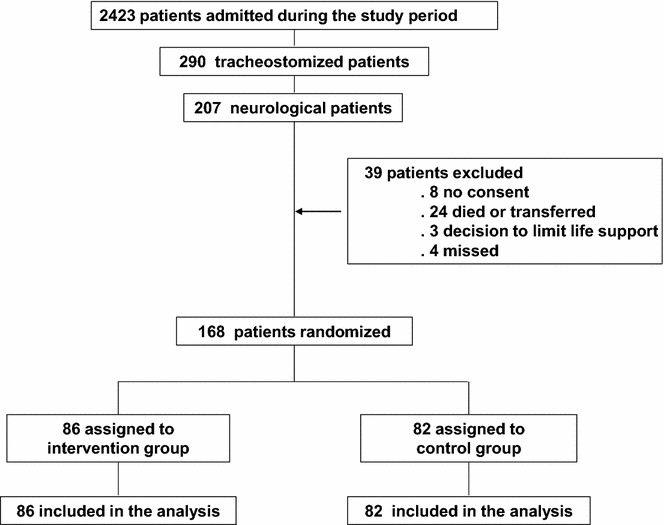Evaluation of a systematic approach to weaning of tracheotomized neurological patients: an early interrupted randomized controlled trial
- PMID: 26698596
- PMCID: PMC4689720
- DOI: 10.1186/s13613-015-0098-0
Evaluation of a systematic approach to weaning of tracheotomized neurological patients: an early interrupted randomized controlled trial
Abstract
Background: While a systematic approach to weaning reduces the rate of extubation failure in intubated brain-injured patients, no data are available on the weaning outcome of these patients after tracheotomy. We aimed to assess whether a systematic approach to disconnect tracheotomized neurological and neurosurgical patients off the ventilator (intervention) is superior to the sole physician's judgment (control). Based on previous work in intubated patients, we hypothesized a reduction of the rate of failure within 48 h from 15 to 5 %. Secondary endpoints were duration of mechanical ventilation, ICU length of stay and mortality.
Methods: We designed a single center randomized controlled study. Since no data are available on tracheotomized patients, we based our a priori power analysis on results derived from intubated patients and calculated an overall sample size of 280 patients.
Results: After inclusion of 168 consecutive patients, the trial was interrupted because the attending physicians judged the observed rate of reconnection to be much greater than expected. The overall rate of failure was 29 %, confirming the physicians' judgment. Twenty-one patients (24 %) in the intervention group and 27 (33 %) controls were reconnected to the ventilator within 48 h (p = 0.222). The main reasons for failure were respiratory distress (80 and 88 % in the treatment and control group, respectively), hemodynamic impairment (15 and 4 % in the treatment and control group, respectively), neurological deterioration (4 % in the control group only). The duration of mechanical ventilation was of 412 ± 202 h and 402 ± 189 h, in the control and intervention group, respectively. ICU length of stay was on average of 23 days for both groups. ICU mortality was 6 % in the control and 2 % in the intervention group without significant differences.
Conclusion: We found no difference between the two groups under evaluation, with a rate of failure much higher than expected. Consequent to the early interruption, our study results to be underpowered. Based on the results of the present study, a further trial should overall enroll 790 patients.
Trial registration: ACTRN12612000372886.
Keywords: Brain-injured patients; Tracheotomy; Weaning.
Similar articles
-
Rate of reintubation in mechanically ventilated neurosurgical and neurologic patients: evaluation of a systematic approach to weaning and extubation.Crit Care Med. 2008 Nov;36(11):2986-92. doi: 10.1097/CCM.0b013e31818b35f2. Crit Care Med. 2008. PMID: 18824909 Clinical Trial.
-
Noninvasive ventilation during weaning.J Physiol Pharmacol. 2007 Nov;58 Suppl 5(Pt 1):335-8. J Physiol Pharmacol. 2007. PMID: 18204144 Clinical Trial.
-
Effect of Acetazolamide vs Placebo on Duration of Invasive Mechanical Ventilation Among Patients With Chronic Obstructive Pulmonary Disease: A Randomized Clinical Trial.JAMA. 2016 Feb 2;315(5):480-8. doi: 10.1001/jama.2016.0019. JAMA. 2016. PMID: 26836730 Clinical Trial.
-
[Investigation of adjuvant treatment for difficult weaning from mechanical ventilation].Zhonghua Wei Zhong Bing Ji Jiu Yi Xue. 2014 Dec;26(12):849-54. doi: 10.3760/cma.j.issn.2095-4352.2014.12.001. Zhonghua Wei Zhong Bing Ji Jiu Yi Xue. 2014. PMID: 25476074 Clinical Trial. Chinese.
-
Effectiveness of dexmedetomidine versus propofol on extubation times, length of stay and mortality rates in adult cardiac surgery patients: a systematic review and meta-analysis.JBI Database System Rev Implement Rep. 2018 May;16(5):1220-1239. doi: 10.11124/JBISRIR-2017-003488. JBI Database System Rev Implement Rep. 2018. PMID: 29762314
Cited by
-
Role of a successful spontaneous breathing trial in ventilator liberation in brain-injured patients.Ann Transl Med. 2021 Apr;9(7):548. doi: 10.21037/atm-20-6407. Ann Transl Med. 2021. PMID: 33987246 Free PMC article.
-
Electrical impedance tomography during spontaneous breathing trials and after extubation in critically ill patients at high risk for extubation failure: a multicenter observational study.Ann Intensive Care. 2019 Aug 13;9(1):88. doi: 10.1186/s13613-019-0565-0. Ann Intensive Care. 2019. PMID: 31410738 Free PMC article.
-
Comparison between a nurse-led weaning protocol and weaning based on physician's clinical judgment in tracheostomized critically ill patients: a pilot randomized controlled clinical trial.Ann Intensive Care. 2018 Jan 22;8(1):11. doi: 10.1186/s13613-018-0354-1. Ann Intensive Care. 2018. PMID: 29356958 Free PMC article.
-
Mechanical ventilation in brain injured patients: seeing the forest for the trees.J Thorac Dis. 2017 Oct;9(10):3483-3487. doi: 10.21037/jtd.2017.08.149. J Thorac Dis. 2017. PMID: 29268322 Free PMC article. No abstract available.
-
Monitoring of Electrical Activity of the Diaphragm Shows Failure of T-Piece Trial Earlier than Protocol-Based Parameters in Prolonged Weaning in Non-communicative Neurological Patients.Neurocrit Care. 2017 Aug;27(1):35-43. doi: 10.1007/s12028-016-0360-9. Neurocrit Care. 2017. PMID: 28063121
References
LinkOut - more resources
Full Text Sources
Other Literature Sources


